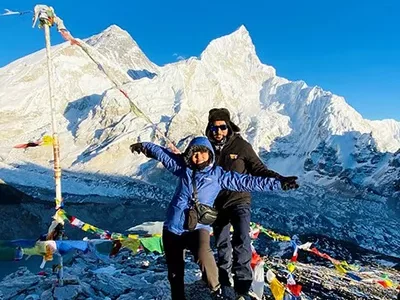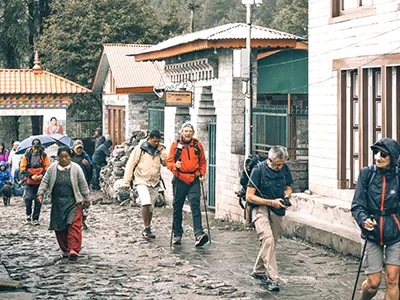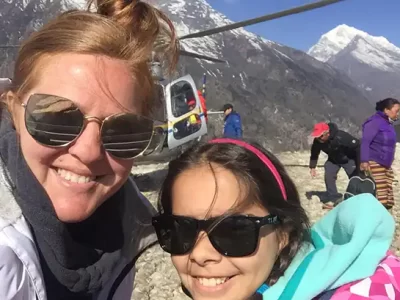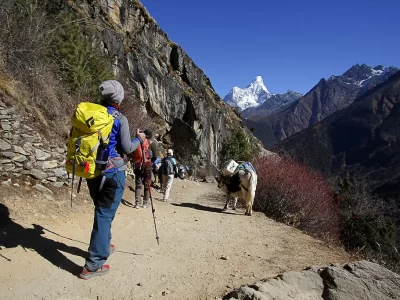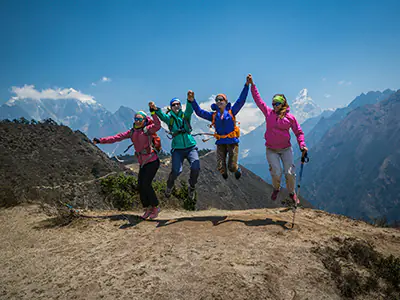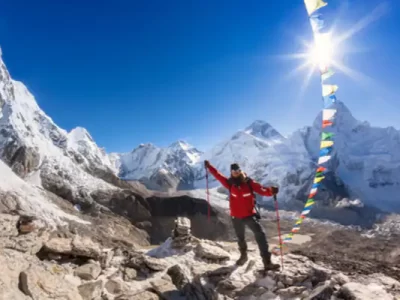Travelers from around the globe flock to the incredible trek at Everest Base Camp (EBC), drawn by the allure of reaching the base of the world’s highest mountain. Spanning approximately 130 kilometers (80 miles) through the Nepalese Himalayas, the trek offers an immersive experience in the beautiful and vibrant Sherpa culture. As trekkers arrive, understanding “How to Avoid Altitude Sickness on Your Everest Base Camp Trek?” becomes crucial. The camp’s altitude of 5,364 meters (17,598 feet) poses a significant challenge, testing the endurance and adaptability of every trekker. Ensuring proper acclimatization and preparation is key to a successful ascent.
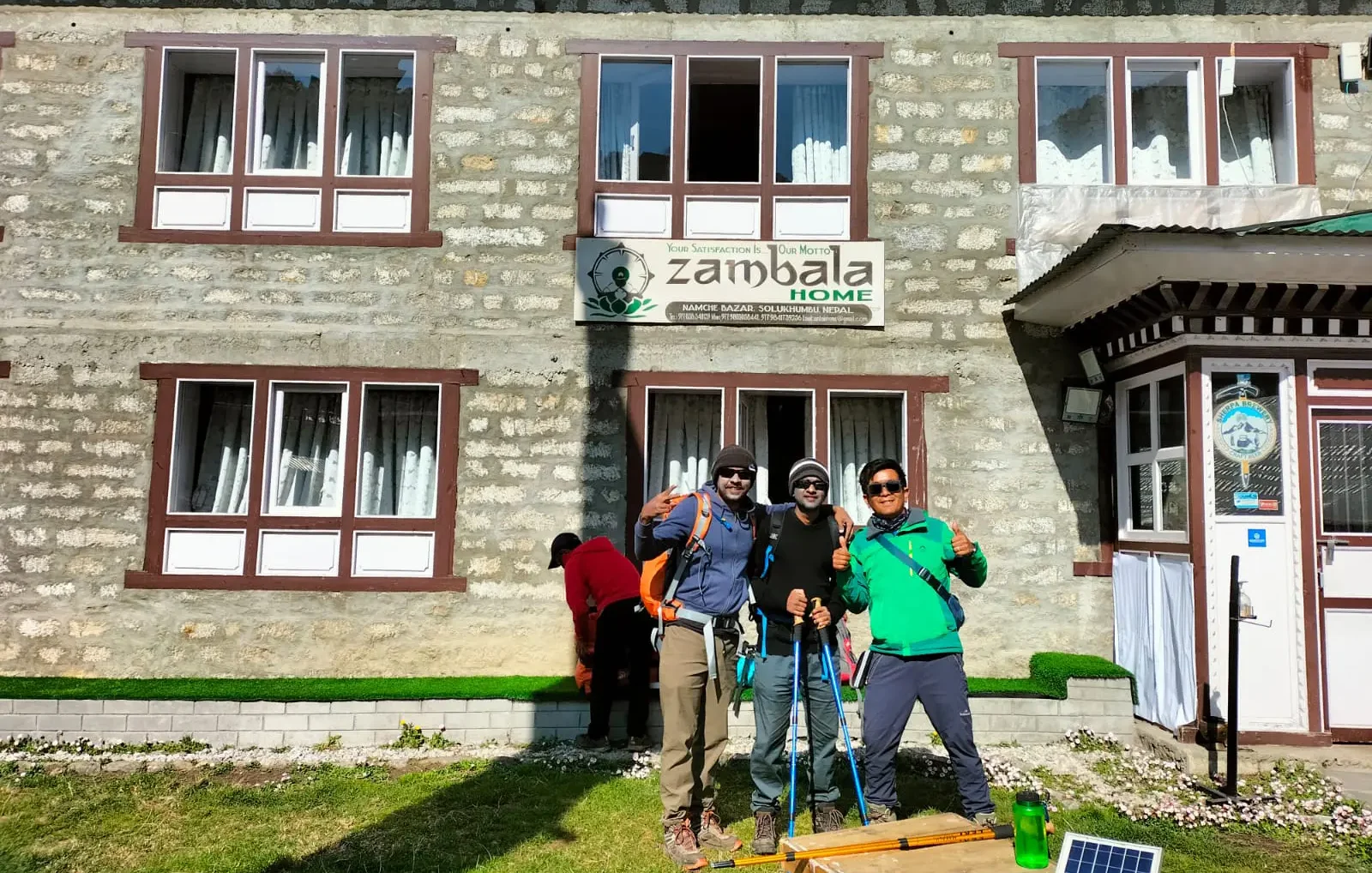
This thin air at high altitudes significantly affects health and productivity, underscoring the importance of understanding and preventing altitude sickness. The story of an experienced traveler illustrates the vital importance of adapting to the weather. Though well prepared physically, they were already climbing too fast for the sake of reaching the base camp. Their rapid ascent showed clear signs of acute altitude sickness (AMS) as they reached Gorak Shep, the last stop before base camp.
It reminded them that physical fitness and mental toughness are less important than other things in mountaineering to realize the regurgitative dynamics of such a mountain. They now understood the advice about acclimatization: it’s not a choice; it’s a necessity. This story points out how hard moving through Everest should be, and it emphasizes the importance of listening to your body when going there.
Everest Base Camp Trek
Luxury Everest Base Camp Trek
Everest Base Camp Trek with Helicopter Return
Understanding Altitude Sickness
The inability of the body to adjust to the lower oxygen levels at high altitudes causes altitude sickness, also known as mountain sickness, which afflicts hikers who ascend to high altitudes, such as those on the Everest Base Camp Trek. Acute Mountain Sickness (AMS), High Altitude Pulmonary Edema (HAPE), and High Altitude Cerebral Edema (HACE) are the three main forms of altitude sickness that trekkers are likely to experience.
Within hours of ascending, the mildest and most common type of mountain sickness, known as acute mountain sickness (AMS), manifests itself. Feelings like headache, nausea, lightheadedness, exhaustion, dyspnea, and disturbed sleep are signs that the body is having difficulty adapting.
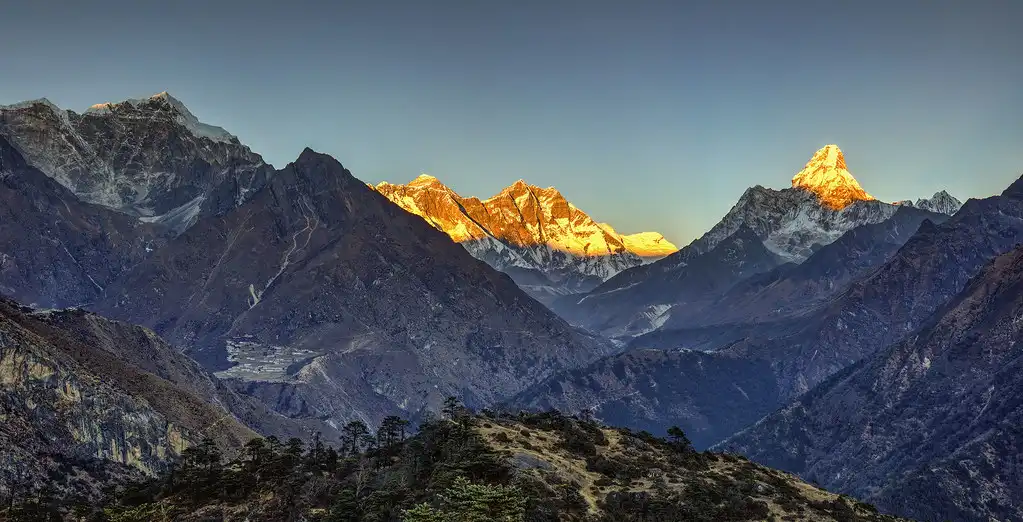
High Altitude Pulmonary Edema (HAPE) presents a more severe condition, with fluid accumulating in the lungs, hindering effective oxygen exchange. Symptoms such as extreme breathlessness, even while resting, a persistent cough producing frothy or pink sputum, fatigue, and chest tightness indicate HAPE. This condition demands immediate descent and medical care as it can be fatal.
Brain swelling results from the most serious type of altitude sickness, known as High Altitude Cerebral Edema (HACE). Signs of HACE include headaches, coordination loss (ataxia), confusion, disorientation, and behavioral changes, requiring urgent descent and medical intervention.
The EBC trek exposes individuals to high altitudes, significantly increasing the risk of these conditions due to rapid ascent to elevations over 2,500 meters (8,200 feet), where oxygen levels drastically drop. Proper acclimatization becomes necessary as the body needs time to adjust to the decreased oxygen availability, and failure to do so can lead to altitude sickness.
Hikers must identify the signs of altitude sickness early on. Early detection of symptoms can lead to immediate measures like resting, hydrating, or descending to lower altitudes, helping prevent the illness from worsening. Overlooking these symptoms can escalate to more severe conditions, posing a serious threat to the trekker’s health. Thus, a safe and successful trip to Everest Base Camp depends on being aware of and responsive to the signs of altitude sickness.
Preparation Before the Trek
The key to enjoying a successful Everest Base Camp (EBC) trek is proper preparation, which covers medical check-ups, fitness training, dietary planning, hydration management, and meticulous packing.
Importance of a Medical Check-up
Undergoing a comprehensive medical check-up becomes essential before starting the trek. This check-up evaluates your overall health, uncovers any underlying issues, and confirms your physical readiness for the trek’s demands. Evaluating heart and lung function is crucial in the oxygen-scarce, high-altitude environments. Healthcare professionals will also recommend necessary vaccinations and medications for travel in Nepal.
Fitness Preparation and Exercises
To boost endurance, strength, and lung capacity for the trek, you must engage in cardiovascular exercises like running, cycling, or swimming, enhancing heart and lung efficiency.
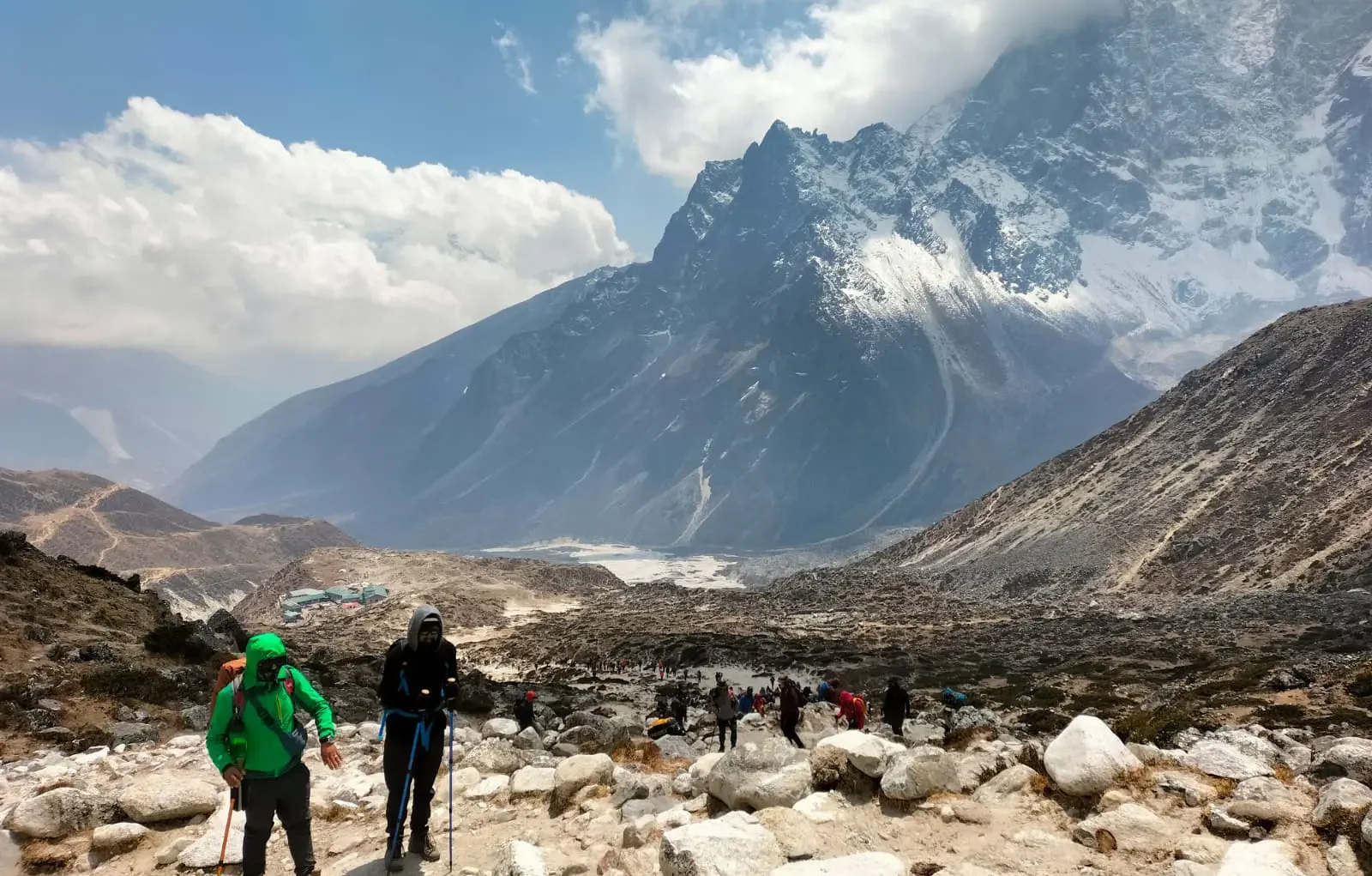
Hiking in hilly or mountainous areas with a loaded backpack mimics the EBC trek conditions, building leg strength and stamina. Step-ups, lunges, and squats are examples of strength-training exercises that strengthen the lower body. Regular yoga or meditation sessions enhance breathing efficiency and mental focus, aiding high-altitude adaptation.
Dietary Considerations and Hydration Tips
A balanced diet high in proteins, lipids, and carbs is necessary to sustain energy levels during the hike. Eating iron-rich foods prevents anemia and boosts oxygen transport. Proper hydration is vital to counteract altitude sickness symptoms; drinking 3-4 liters of water daily while trekking is essential. Using hydration supplements, such as electrolyte tablets, helps maintain fluid balance.
Packing List: Essential Items to Monitor and Alleviate Altitude Sickness Symptoms
Your packing list should feature items that monitor and mitigate altitude sickness symptoms. Must-have items include:
- Acetazolamide (Diamox) is used to prevent and reduce symptoms of altitude sickness.
- We use an altitude sickness meter to track blood oxygen saturation levels.
- Pain relievers like ibuprofen or acetaminophen for headache management.
- Anti-nausea medication to relieve nausea or vomiting.
- Hydration packs and water purification tablets to secure clean drinking water.
- Energy snacks such as nuts, chocolate, and energy bars for sustained energy.
- Warm and layered clothing to manage varying temperatures and avoid hypothermia.
Everest Base Camp Short Trek
Everest Base Camp Trek for Beginners
Jiri to Everest Base Camp Trek
Acclimatization Strategies
Acclimatization, essential for high-altitude treks like the Everest Base Camp (EBC) Trek, enables the body to adjust to lower oxygen levels and higher elevations, reducing altitude sickness risk and enhancing trek safety and enjoyment.
Explanation of Acclimatization and Its Importance
During acclimatization, the body undergoes physiological changes: it increases red blood cell production, improves oxygen delivery to muscles, and elevates the breathing rate. At high elevations, these adaptations mitigate the impacts of decreasing oxygen availability and air pressure. Neglecting acclimatization can provoke severe altitude sickness, threatening the trek’s health and success.
Recommended Acclimatization Schedule for the EBC Trek
The EBC trek’s acclimatization schedule should include a controlled ascent to allow the body to adjust properly. Essential guidelines are:
Limit sleeping altitude gains to 300-500 meters (1,000-1,600 feet) per day beyond 3,000 meters (10,000 feet).
Plan rest days after every 600-900 meters (2,000-3,000 feet) of elevation gain at places like Namche Bazaar and Dingboche or Pheriche.
Engage in “climb high, sleep low” activities on these rest days, hiking to higher altitudes by day and sleeping at lower altitudes by night.
Importance of a Slow Ascent Rate and Listening to Your Body
A gradual ascent is crucial for acclimatization, and heeding the body’s signals like headaches, nausea, and fatigue is vital to avoid overexertion and subsequent health complications.
Tips for Sleeping at High Altitudes
To manage the challenges of sleeping at high altitudes, caused by lower oxygen levels and potential altitude sickness symptoms, you should:
- Avoid strenuous activities during the day to minimize increased heart rate and metabolism at night.
- Consume a light evening meal and steer clear of caffeine or alcohol before sleep.
- Use suitable sleeping gear to stay warm, as cold temperatures can affect sleep quality.
- Consider prescribed altitude sickness medication like Acetazolamide to aid respiration and sleep if problems persist.
During the Trek: Recognizing and Managing Symptoms
Successfully navigating the Everest Base Camp (EBC) Trek involves actively monitoring health and effectively responding to altitude sickness symptoms. This proactive management is crucial for the safety and well-being of the trekkers.
Daily Health Checks and Symptom Tracking
Trekkers must perform daily health checks to watch for altitude sickness symptoms, such as headaches, nausea, fatigue, and dizziness. Maintaining a symptom diary proves beneficial for noting health status changes over time. This documentation assists in recognizing patterns and assessing whether symptoms are improving or deteriorating, which is essential for making informed decisions about whether to ascend or descend.
What to Do if Symptoms of Altitude Sickness Appear
When symptoms of altitude sickness surface, immediate action is crucial. Trekkers should stop any further ascent and rest at the current altitude to see if symptoms subside. Drinking plenty of fluids and eating light can help alleviate symptoms. If symptoms persist or intensify, the trekker must descend to a lower altitude. In severe cases, they are seeking medical attention and consider evacuation necessary.
The Role of Guides and Porters in Monitoring Trekkers’ Health
Guides and porters are vital in monitoring the health and safety of trekkers, with training that equips them to spot early signs of altitude sickness and other health concerns. They can decide whether to start descending or continue climbing because of their experience and knowledge. Open communication with guides about their health conditions enables trekkers to receive the necessary assistance.
When to Make the Decision to Descend
Deciding to descend becomes imperative when symptoms of altitude sickness do not ease with rest or worsen progressively. Descending offers the most effective treatment for altitude sickness by providing access to more oxygen. If a trekker experiences severe symptoms like extreme fatigue, breathlessness at rest, or cognitive issues such as confusion or impaired walking, initiating an immediate descent is critical. Delaying descent can lead to severe, life-threatening complications.
In managing symptoms of altitude sickness during the EBC Trek, trekkers must balance their ambition with safety, taking a proactive approach to health monitoring, listening to experienced guides’ advice, and prioritizing health over summiting.
Medication and Remedies
Managing altitude sickness effectively during the Everest Base Camp (EBC) Trek requires appropriate medication and remedies.
Overview of Medications like Acetazolamide (Diamox) and Their Proper Use
Doctors often prescribe Acetazolamide (Diamox) to both prevent and treat altitude sickness symptoms. This medication acidifies the blood, leading to stimulated breathing and faster acclimatization. The typical recommended dose ranges from 125-250 mg twice a day, starting one to two days before the climb and continuing at the highest reached altitude or until the beginning of the descent. Trekkers must follow their healthcare provider’s prescription and advice carefully to avoid side effects.
Natural Remedies and Preventive Measures
Natural remedies and lifestyle adjustments can also support acclimatization—adequate hydration, a carbohydrate-rich diet, and avoiding alcohol and tobacco form part of this strategy. Although the effectiveness of herbal supplements like Gingko Biloba in preventing altitude sickness remains uncertain, they can serve as complementary to established preventive measures.
The Role of Supplemental Oxygen and When It’s Needed
Supplemental oxygen becomes essential for trekkers with severe altitude sickness or those whose symptoms do not improve with descent or medication. It increases blood oxygen saturation, relieving symptoms, particularly in emergencies or for individuals more susceptible to altitude sickness.
Importance of a Flexible Itinerary
A flexible itinerary is essential for adapting to the challenges of high-altitude trekking.
The Need for Built-in Rest Days and Contingency Plans
Integrating rest days into the itinerary promotes acclimatization and reduces altitude sickness risks. These days also serve as a buffer to manage unexpected issues like adverse weather or health problems. Establishing contingency plans, including alternate descent routes and medical facility access, is vital for effective emergency response.
Real-life Stories of Trekkers Who Had to Adjust Their Plans
The unpredictability of high-altitude trekking has led many trekkers to modify their plans due to altitude sickness or unexpected situations. Flexibility is underscored by these adaptations, including extending the trek and making necessary descents for health reasons.
How Weather and Physical Conditions Can Affect Your Trek Itinerary
In the Himalayas, where weather can shift suddenly, impacting trek progress and safety, a trekker’s varying physical condition due to altitude, exertion, and health also calls for an adjustable trekking plan. Ensuring the trekking group’s health and safety requires that the itinerary change to reflect the present circumstances.
Safe Trekking Practices
Ensuring a safe and enjoyable Everest Base Camp (EBC) Trek hinges on practicing safe trekking methods.
Importance of Trekking with a Reputable Guide or Tour Company
I would like to assure you that securing a reputable guide or tour company is essential. Such guides bring knowledge and skills crucial for safely navigating the route, managing logistics, and handling emergencies like altitude sickness. They improve the entire trekking experience, uphold safe hiking practices, and offer insights into the local geography and culture.
Staying Hydrated and Eating Properly on the Trek
Throughout the walk, staying hydrated and eating a healthy diet are crucial to avoiding altitude sickness and maintaining good health. To prevent dehydration, a condition that can worsen altitude sickness symptoms, consider drinking 3-4 liters of water daily. Trekking requires great physical exertion, which can be fueled by eating a well-balanced diet high in carbohydrates, proteins, and lipids.
The Buddy System: Looking Out for Each Other
Implementing the buddy system allows trekkers to keep an eye on each other’s health and safety, proving potentially lifesaving. This practice ensures quick identification and response to any signs of altitude sickness or health issues, facilitating immediate support and action.
Conclusion
To prevent altitude sickness on the EBC Trek, one must prepare meticulously, acclimatize properly, and follow safe trekking guidelines. It’s essential to get a medical check-up before the trek, engage in physical preparation, ensure adequate hydration, consume a nutritious diet, ascend slowly, and heed your body’s signals. Taking symptoms of altitude sickness seriously and descending when necessary are crucial steps.
You can approach the Everest Base Camp trek with safety as the top priority. Proper preparation and mindset enable the enjoyment of the Himalayas’ stunning landscapes safely. While the beauty of the mountains beckons, respecting the mountain’s challenges and prioritizing health is paramount.

